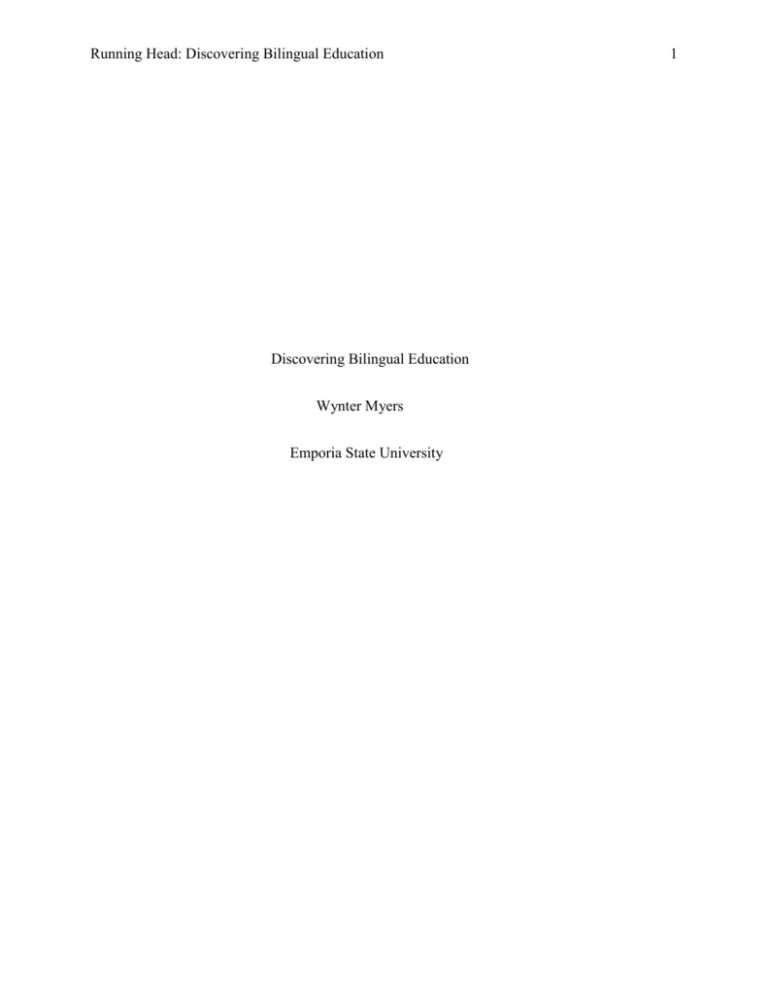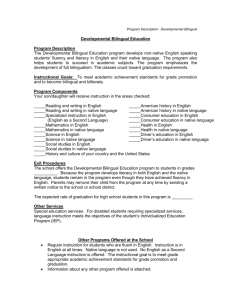LI813 Client Diagnosis and Recommendation
advertisement

Running Head: Discovering Bilingual Education Discovering Bilingual Education Wynter Myers Emporia State University 1 Running Head: Discovering Bilingual Education 2 To complete this assignment I asked a friend, Mr. F., to help me. Mr. F is a 29 year old graduate student in his last year at Wichita State University. His field of study is languages with an emphasis on Spanish and French. He is also very interested in the quality of education of Latin American people, and is currently conducting a study about the bilingual skills of early elementary students in the Wichita, Kansas area. I’ve known Mr. F. for almost two years. Mr. F.’s initial information need was knowledge about developmental psychology. To find out more about his question we met over coffee, and being friends both of our body language styles were very casual. The need was not an immediate one, so while there was some pressure to eventually find the necessary information, the meeting was not urgent. That day we both understood that my questions would not garner immediate results as I was only learning more about his intended goal for the assignment so we set a date a week in advance by which time I was to have suggestions for him to look over. I began my inquiry with the question “You said you wanted information about Developmental Psychology for a homework assignment. Is there anything specific you needed to know?” He answered “I don’t really know anything about developmental psychology. I guess I want to know about children’s mental development.” I answered “So children’s developmental psychology (taking notes at this point). Is there a specific group of children you had in mind? Such as a certain age group or did you want all ages of childhood development?” “Well, I’m really looking more for early childhood development around kindergarten age so 4-6 years of age roughly.” “Was there anything else you wanted to know about how 4-6 year olds develop?” He stated “Yes, I’d like to know about their education, specifically bilingual education.” Knowing his areas of interest I ask “Did you want information covering all bilingual children or only those Running Head: Discovering Bilingual Education 3 who speak Spanish or French?” “Either French or Spanish will do, although you’ll probably have more luck with Spanish.” “What information did you need about bilingual education?” He replies “I was thinking some information about both sides of the issue, you know, those for bilingual education and those against it.” “Did you also want to look at information about the (ESL) English as Second Language programs in schools?” “Sure why not.” Then I ask “What type of sources do you need to meet your requirements for the assignment?” “I don’t really have any requirements aside from not using Wikipedia as one of my sources. I guess books, magazines, and journal articles are all ok.” My final question asked on this date was “Do you already have any sources about bilingual education that you plan to use, so I know what you already have.” “I get the journal for Latin American and Spanish teachers, but otherwise I haven’t begun to collect information.” When I began this task, I thought Mr. F. would know exactly what type of information he needed for his assignment, as was my previous experience with him. However, as is obvious from our conversation, Mr. F. was undecided about the initial subject, but became more certain of the course of action he wanted to take as I asked more questions. When I started asking questions I tried to remember what Grover and Carabell (1995) said about the diagnostic process. “A successful diagnosis is accomplished (1) by establishing a comfortable clientprofessional relationship, (2) by determining the context for the information need, (3) by determining the information use preferences of the user, (4) by ascertaining limitations the user may have, and (5) by continuously evaluating the effectiveness of the diagnosis in identifying and addressing the information needs of the client.” I believe that I achieved the first four steps in the initial interview phase of the project. The fifth step I accomplished through the continual evaluation of the sources and the needs of the client, but I’ll address this issue later in the paper. I also tried to remember Dervin and Dewdney’s Running Head: Discovering Bilingual Education 4 (1986) “Neutral Questioning: A New Approach to the Reference Interview.” I know that I used open questions, closed questions, and sometimes I asked an open and then a closed question about the same topic. I only used one or two neutral questions, however. I need to get comfortable with using neutral questioning. After the interview I first began searching in the Wichita Public Library website. I knew that whatever sources I found would need to be accessible to Mr. F. so this was a good place to start. I input into the catalog the phrase developmental psychology. I did not see sources relating to children’s education so changed my search topic to psychology. I found a resource and looked at the index for ideas. A couple of terms that it contained were educational psychology and child psychology. I also tried those terms only finding a few items that might work. I then checked under the phrase bilingual education. I found several more print sources that might work for Mr. F. Thinking that I might be more successful with journal articles I searched through the Emporia State University online journal database. Here I used Wilson Omnifile: Full Text and General OneFile for all of the aforementioned terms. I also used the suggestions that appear on the left side of the screen for things similar topics like English as a second language, immersion method, and Hispanic American Youth/ education. Overall, I found 20-25 good sources I thought might work for his project. Some print sources, but mostly online journal articles or other periodicals. I know that during the search there was some personal bias on my part in regards to what he might or might not view as relevant. Perhaps this is because I know the client and/or perhaps it is just part of trying to find the right combination of information for the client’s needs as I see them. This search took three or four hours over a couple of days. Realistically, in a Running Head: Discovering Bilingual Education 5 library situation I would probably not have that much time to devote to helping one person find materials for a project. Once I had compiled my sources I turned them over to Mr. F. asking that he check to see if these fit his need and let me know if they would suffice. If they did not cover his needs we would continue searching after I had asked a few more questions. His reply was that the sources I had given him would more than cover his information need and with one exception the sources were completely relevant to his assignment. The one exception was due to unsubstantiated statistics rather than unsuitability of topic. He also felt that I had asked pertinent questions without prying into his personal business and that the whole process was not stressful in the least. This is saying something because Mr. F. believes that he does not need to ask a librarian for help because he is almost finished with his Master’s degree and should know how to find his own information by now. Overall I believe that the search process went very well. Because I knew the client it was easier to diagnose his need than it would have been if it were someone I did not know. He also was forthcoming about his need because it was something that was not embarrassing or difficult to articulate. The search might have been quicker if I knew more about the subject he was looking for, but by accessing the index of the psychology book and observing the keyword phrases related to the terms I already knew, finding the appropriate information was simpler than it could have been. The interview also went well for the same reasons as the search did. I have already mentioned that I am comfortable using the open and closed methods of questioning and that with a little practice I could get better at the neutral style. I think the way in which I used closed Running Head: Discovering Bilingual Education 6 questions still allowed for the opportunity to gain information about the client’s needs. I established a comfortable relationship with Mr. F., figured out why he needed the information, how it was going to be use and what formats he needed to access the information in, determined any restrictions or complications related to the need, and continued to evaluate the need and the sources found for the client. The one thing that might have made the interview easier, in terms of the actual search, was if we had met at the library or somewhere with internet access to do the search as we were chatting rather than waiting until later when the memories of our conversation were not as fresh. Ultimately, the goal was to successfully interview, diagnose, treat, and evaluate the need of the client, all of which I did. Running Head: Discovering Bilingual Education References Dervin, Brenda and Patricia Dewdney. "Neutral Questioning: A New Approach to the Reference Interview." Reference Quarterly 25(4), 506-513 (Summer 1986). Grover, R. and Carabell, J. (1995). Toward better information service: diagnosing information needs. Special Libraries, 86(1), 1-10 (Winter 1995). 7








